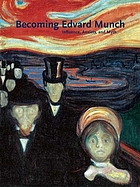 Becoming Edvard Munch
by
Jay A. y. Clarke
Becoming Edvard Munch
by
Jay A. y. Clarke
 Munch
by
Steffen Kverneland(Author)(Illustrator)Francesca Nichols(Translator)
Munch
by
Steffen Kverneland(Author)(Illustrator)Francesca Nichols(Translator)
